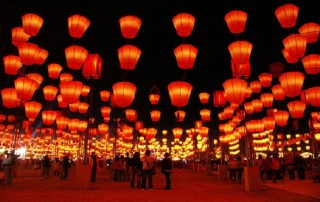The last day of firecrackers, fireworks and numerous meals with family and friends has arrived to celebrate the beginning of a new year! Today, February 6th, is the day of the Chinese Lantern Festival, which culminates the end of the Chinese New Year celebrations. The main attraction of the festival are (very obvious) the lanterns. But that is not all! Hereunder you will find out all about how Chinese people celebrate the Lantern Festival.
Lanterns
 Making lanterns is an important part of the Lantern Festival celebration (of course you can also just buy them if you are not gifted with great creative skills). The variety of lanterns is limitless! Although the simple red lantern stays the most popular one, people nowadays make lanterns in all different colors, shapes and sizes: they represent the 12 animals of the zodiac, heroic figures or historical scenes.But where does the practice of lighting and watching lanterns come from? Well, it dates back to the introduction of Buddhism in the Han Dynasty! As ancient India would hold celebrations on the fifteenth day of the first month of the new year to worship the Buddha, palaces and temples were commanded to lighten lanterns in order to show respect to Buddhism. Later on this custom of lighting lanterns would be passed on to the common people.
Making lanterns is an important part of the Lantern Festival celebration (of course you can also just buy them if you are not gifted with great creative skills). The variety of lanterns is limitless! Although the simple red lantern stays the most popular one, people nowadays make lanterns in all different colors, shapes and sizes: they represent the 12 animals of the zodiac, heroic figures or historical scenes.But where does the practice of lighting and watching lanterns come from? Well, it dates back to the introduction of Buddhism in the Han Dynasty! As ancient India would hold celebrations on the fifteenth day of the first month of the new year to worship the Buddha, palaces and temples were commanded to lighten lanterns in order to show respect to Buddhism. Later on this custom of lighting lanterns would be passed on to the common people.
Riddles
Lanterns not only provide aesthetic pleasure. They also serve to celebrate Chinese history! Chinese people love to guess the meaning of the riddles written on lanterns. Sometimes even riddle parties would be organized at temples during the night of the Lantern Festival. Subjects range from traditional Chinese poems to songs and stories.
Guessing lantern riddles emerged in the Song Dynasty where vendors would write riddles on paper notes and stick them to lanterns hanging outside their shop. Visitors who think they know the answer, could pull out the paper, go to the vendor and check the answer. If they are right, they get a small gift.
Tangyuan
For centuries already, people eat tāngyuán (汤圆 – rice dumplings) on the eve of the Lantern Festival together with friends and family. Tāngyuán has a similar pronunciation as tuányuán (团圆), meaning reunion and their shape is harmonious with the full moon.
They are made of glutinous rice flour and have different fillings stuffed inside: sugar, sesame, walnuts, bean paste and even rose petals just to name a few.
Attending Lantern Festival Activities
All around big cities there are a lot of festivities on the street and in temples to celebrate the Lantern Festival. In Beijing for instance you can go to Qiánmén dàjiē (前门大街) to enjoy some lion dance, dragon dance, lanterns ceremony, Chinese opera show, magic show and acrobatics show. Yùyuán Garden (豫园) on the other hand, serves as a major venue to celebrate the Lantern Festival in Shanghai where you can admire lanterns, attend a lantern riddle quiz, eat tāngyuán and enjoy a 60-meter dragon dance!